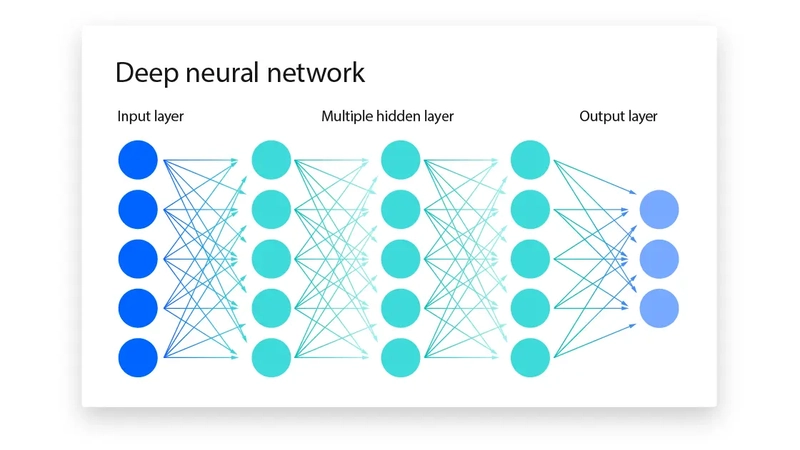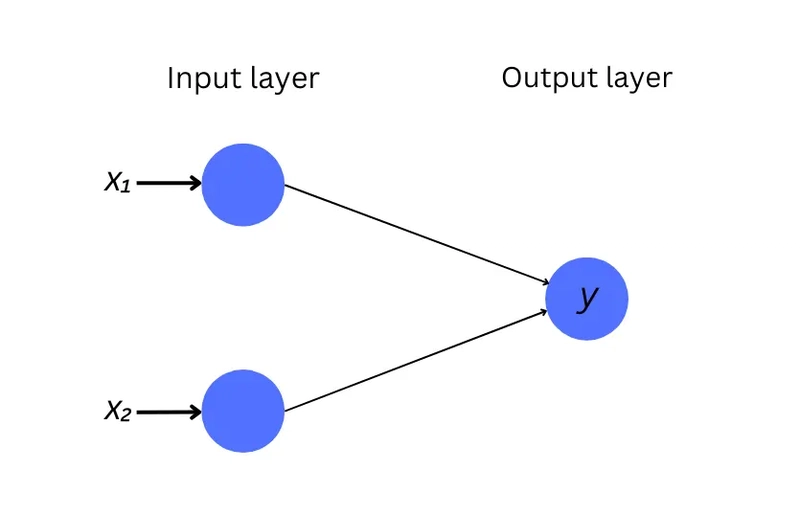用 Rust 构建神经网络(从头开始)
让我们从零开始构建一个神经网络,以真正理解它们的工作原理。我所说的“从零开始”,是指不使用任何复杂的机器学习或线性代数库。我们将构建一个单层感知器,这是最简单的神经网络,然后教它对两个数字进行加法运算。
我将使用 Rust 语言,但如果您愿意,也可以使用 JavaScript 或 Python 实现。代码可在此处获取。
神经网络
神经网络顾名思义,就是一个人工神经元组成的网络。神经元或“节点”是模拟生物神经元功能的计算单元。它接收输入,进行数学运算,然后输出结果。
我们首先定义一个NeuralNetwork结构体,并关联一个方法来初始化它。目前我们还没有太多内容,所以暂时先留空。
struct NeuralNetwork {}
impl NeuralNetwork {
fn new() -> Self {
Self {}
}
}
图层
神经网络中的神经元被划分为不同的层级,称为层。每一层都以某种方式处理输入,每一层的输出作为下一层的输入。第一层接收初始输入,最后一层产生最终输出。中间的层称为隐藏层,用于从数据中提取和转换特征。
每个圆圈代表一个神经元,每条线代表一个连接。你可以看到,每一层中的每个神经元都与下一层中的每个神经元相连。
我们正在构建的神经网络如下所示。它有两个输入神经元(每个数字一个)和一个输出神经元。注意,它没有任何隐藏层。
权重
神经网络中的每个连接都有一个关联的权重。这些权重决定了神经元之间关系的强度和方向(正向或负向影响),进而影响数据在从一层传递到下一层时如何转换。在训练过程中,我们会调整这些权重值以减少输出中的误差。
思考权重的一个好方法是将神经连接想象成将信号(数据)从一个神经元传输到另一个神经元的管道。这些管道的粗细可以改变。管道越粗,意味着它所代表的连接越强,对通过它的信号的影响就越大。
由于我们的网络中没有隐藏层,我们只需要两个权重(每个连接一个)。我们暂时将它们初始化为随机浮点值。
struct NeuralNetwork {
weights: Vec<f64>
}
impl NeuralNetwork {
fn new() -> Self {
let mut rng = rand::thread_rng();
let weights = vec![rng.gen_range(0.0..1.0), rng.gen_range(0.0..1.0)];
Self {
weights
}
}
}
偏见
偏差是另一个调整神经元输出的参数。想象一下,每个神经元旁边都有一个小旋钮。无论神经元接收到什么信号,这个旋钮都可以调节神经元的活跃程度。这就像调整神经元的基线活动水平,确保即使所有输入信号都很弱,神经元仍然可以根据这个偏差调整来选择触发(激活)。
只有隐藏层和输出层的神经元才有偏差。由于我们的感知器没有隐藏层,并且输出层只有一个神经元,所以我们只需要一个偏差值,并将其初始化为一个随机值。
struct NeuralNetwork {
// [...]
bias: f64
}
impl NeuralNetwork {
fn new() -> Self {
// [...]
Self {
// [...]
bias: rng.gen_range(0.0..1.0)
}
}
}
激活函数
激活函数决定神经元是否应该激活。它就像一个过滤器或守门人,接收输入信号(经过权重和偏差的修改后),并决定神经元的激活亮度。激活函数用于在网络中引入非线性。这种非线性使网络能够学习复杂的模式。
神经元的输出可以计算如下:
我们将传出连接的权重乘以输入,加上偏差,并对结果应用激活函数。
impl NeuralNetwork {
// [...]
fn predict(&self, input: &[f64; 2]) -> f64 {
let mut sum = self.bias;
for (i, weight) in self.weights.iter().enumerate() {
sum += input[i] * weight;
}
sigmoid(sum)
}
}
Sigmoid 是一个相对简单的非线性激活函数。它的作用是将参数转换为 0 到 1 之间的值,但转换过程并非线性的。尝试用不同的值调用它,看看它是如何工作的。
fn sigmoid(x: f64) -> f64 {
1.0 / (1.0 + (-x).exp())
}
反向传播
这是训练神经网络的关键算法。如果最终输出不符合预期,我们会将误差“反向”传播到网络的各个层,找出哪些路径(连接)对最终输出的整体误差贡献了多少。然后,我们会利用这些信息微调网络中的权重和偏差,以减少未来输出的误差。我们不断重复这个过程,逐渐优化网络参数,直到其输出足够接近我们的预期。
impl NeuralNetwork {
// [...]
fn train(&mut self, inputs: Vec<[f64; 2]>, outputs: Vec<f64>, epochs: usize) {
for _ in 0..epochs {
for (i, input) in inputs.iter().enumerate() {
// Get a prediction for a given input
let output = self.predict(input);
// Compute the difference between the actual and the desired output
let error = outputs[i] - output;
// Find the gradient of the loss function
// (sort of like a hint about the direction to adjust the weights in)
let delta = derivative(output);
// Adjust the weights and the bias to reduce error in the output
for j in 0..self.weights.len() {
self.weights[j] += self.learning_rate * error * input[j] * delta;
}
self.bias += self.learning_rate * error * delta;
}
}
}
}
fn derivative(x: f64) -> f64 {
x * (1.0 - x)
}
一个epoch指的是对整个训练数据集进行一次完整的遍历。在每个 epoch 中,我们将训练数据中的每组输入输入到我们的网络中,将其输出与预期结果进行比较,并利用差异重新调整其参数。我们会重复此过程多个 epoch,以优化模型的性能。
最后一步是将学习率添加到我们的网络。它是一个常数值,决定了模型从错误中学习的速度。我们将其设置为0.1。
struct NeuralNetwork {
// [...]
learning_rate: f64,
}
impl NeuralNetwork {
fn new() -> Self {
// [...]
Self {
// [...]
learning_rate: 0.1,
}
}
现在我们的神经网络已经准备好了,让我们使用它。
fn main() {
let d = data::get_data().unwrap();
let inputs = d.training_inputs;
let outputs = d.training_outputs;
let test_inputs = d.test_inputs;
// Initialize the network
let mut neural_net = NeuralNetwork::new();
for input in test_inputs.iter() {
// Pass a set of inputs (two numbers) and get a prediction back which should be a sum of the two numbers
let prediction = neural_net.predict(input);
println!("Input: {:?}, Prediction: {:.1}", input, prediction);
}
}
如果你运行它,你会得到一些像这样的输出。
Input: [0.9, 0.1], Prediction: 0.7
Input: [0.5, 0.5], Prediction: 0.7
Input: [0.2, 0.3], Prediction: 0.7
Input: [0.3, 0.6], Prediction: 0.7
Input: [0.1, 0.7], Prediction: 0.7
Input: [0.3, 0.1], Prediction: 0.7
Input: [0.1, 0.5], Prediction: 0.7
Input: [0.9, 0.0], Prediction: 0.7
Input: [0.3, 0.3], Prediction: 0.7
Input: [0.0, 0.1], Prediction: 0.6
Input: [0.1, 0.2], Prediction: 0.7
Input: [0.2, 0.0], Prediction: 0.6
Input: [0.6, 0.1], Prediction: 0.7
Input: [0.5, 0.3], Prediction: 0.7
Input: [0.9, 0.1], Prediction: 0.7
Input: [0.1, 0.4], Prediction: 0.7
Input: [0.2, 0.4], Prediction: 0.7
Input: [0.7, 0.0], Prediction: 0.7
Input: [0.6, 0.3], Prediction: 0.7
Input: [0.2, 0.2], Prediction: 0.7
Input: [0.1, 0.0], Prediction: 0.6
Input: [0.2, 0.6], Prediction: 0.7
Input: [0.5, 0.0], Prediction: 0.7
Input: [0.6, 0.4], Prediction: 0.7
Input: [0.4, 0.5], Prediction: 0.7
我们可以看到,我们的网络在数字加法方面表现非常糟糕。25 次预测中只有 2 次正确,而且完全是随机的。这是因为我们还没有对它进行训练。让我们添加训练步骤。
let mut neural_net = NeuralNetwork::new();
// Train for 10000 epochs
neural_net.train(inputs, outputs, 10000);
再次运行它并...
Input: [0.9, 0.1], Prediction: 0.9
Input: [0.5, 0.5], Prediction: 0.9
Input: [0.2, 0.3], Prediction: 0.5
Input: [0.3, 0.6], Prediction: 0.9
Input: [0.1, 0.7], Prediction: 0.8
Input: [0.3, 0.1], Prediction: 0.4
Input: [0.1, 0.5], Prediction: 0.6
Input: [0.9, 0.0], Prediction: 0.9
Input: [0.3, 0.3], Prediction: 0.6
Input: [0.0, 0.1], Prediction: 0.1
Input: [0.1, 0.2], Prediction: 0.3
Input: [0.2, 0.0], Prediction: 0.2
Input: [0.6, 0.1], Prediction: 0.7
Input: [0.5, 0.3], Prediction: 0.8
Input: [0.9, 0.1], Prediction: 0.9
Input: [0.1, 0.4], Prediction: 0.5
Input: [0.2, 0.4], Prediction: 0.6
Input: [0.7, 0.0], Prediction: 0.7
Input: [0.6, 0.3], Prediction: 0.9
Input: [0.2, 0.2], Prediction: 0.4
Input: [0.1, 0.0], Prediction: 0.1
Input: [0.2, 0.6], Prediction: 0.8
Input: [0.5, 0.0], Prediction: 0.5
Input: [0.6, 0.4], Prediction: 0.9
Input: [0.4, 0.5], Prediction: 0.9
哇!它猜对了大约 80% 的答案。还不错。
我们的模型之所以有效,是因为我们试图解决的问题极其简单。能够“记住”更复杂模式的大型神经网络可以拥有跨越多层的数十万个神经元,以及诸如卷积神经网络或循环神经网络等复杂的架构。例如,GPT-3 据称拥有 1750 亿个参数,而其继任者 GPT-4 则据称拥有 1.76 万亿个参数。相比之下,我们的模型只有 3 个参数(2 个权重 + 1 个偏差)。
好了,现在你已经完成了。一个用 Rust 从头开始构建的神经网络。
鏂囩珷鏉ユ簮锛�https://dev.to/farshed/building-a-neural-network-in-rust-from-scratch-5bm1 后端开发教程 - Java、Spring Boot 实战 - msg200.com
后端开发教程 - Java、Spring Boot 实战 - msg200.com

